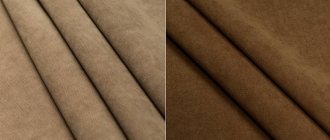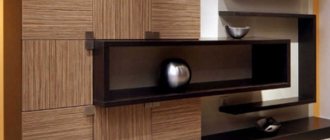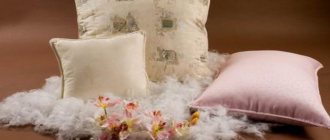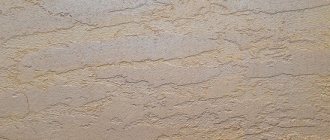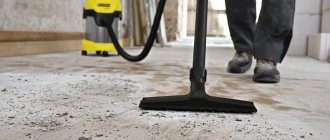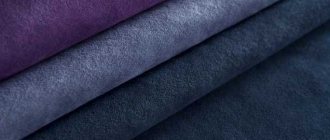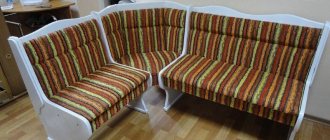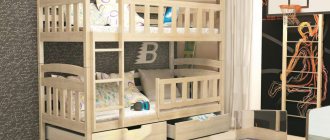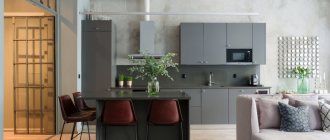Wood is the most environmentally friendly material, but products made from pure wood are very expensive, so most composite materials such as MDF, chipboard, and fiberboard are used for the manufacture of various items.
However, these materials themselves look unpresentable, and veneers of various types of wood give them an original and natural look. And consumers often don’t even realize that the product offered is not made from real wood.
What is veneer
Veneer is a material that is the thinnest sheet of wood, not exceeding a thickness of 10 mm, and obtained as a result of cutting from a round log or beam. The word itself is translated from the German language as “chips.”
The main advantage of this plate is that it retains the grain of the wood corresponding to the type of wood from which it is made. It is impossible to repeat the pattern of wood fibers artificially, because each tree, like a living organism, is unique in its own way.
Wood chips make it possible to significantly reduce the cost of products made under the guise of natural wood. If, for example, one cubic meter of wood can be used to make two chests of drawers, then from chipboard panels covered with veneer obtained from the same cubic meter of wood, ten times more similar products will be obtained.
What is veneer called?
Veneer is a word of German origin meaning wood chips. Apparently, at the time the term was borrowed, they were synonymous. Nowadays, wood chips mean chopped wood. There are several types of wood chips, the best of which are called technological. After additional chemical treatment, some of them are used in the production of boards from wood fibers and chips.
All modern types of veneer are obtained by more subtle mechanical methods of wood processing, for which special technological equipment is used. As a result, plates of small thickness and relatively large (for crushed raw materials) surface area are formed. They don't look like wood chips at all.
The advantages of veneered products are as follows:
- the coating has a beautiful pattern, which is further enhanced during processing;
- veneer of exotic species can be used to decorate a base made of inexpensive wood;
- in case of minor damage, the appearance of the surface can be easily corrected by minor repairs;
- veneer allows you to restore old structures and products without large financial costs;
- a thin layer of coating allows you to carry out the work yourself using ordinary tools.
When working with solid natural wood, you have to make a lot of physical effort, use woodworking machines and special tools, but working with veneer is much easier.
Types of veneer
According to the method used in its production, it is divided into:
- Peeled
- Planed
- sawn
Let's look at them in order:
Peeled
Peeled is obtained as a result of cutting from a round log, which rotates in a special peeling machine, clamped at the ends, while a long horizontal cutter, as it were, strips the log, removing thin plates from it.
Such material, after appropriate processing, is used to make multilayer plywood.
Planed
Sliced veneer is obtained as a result of planing wooden beams and is used in furniture production, for finishing various structures - doors, in the interior of car interiors, as a material for inlay.
This type is mainly made from coniferous and larch species and various growths on the tree, called burls.
sawn
Accordingly, sawn thin plates are made from round logs or square or rectangular beams, but using special saws.
Veneer types
In addition to the above types, veneer is divided according to the method of cutting planed wood and is:
- Radial (R), when tree rings located in parallel completely cover the entire material
- Semi-radial (SR), in which case parallel stripes of growth rings can occupy 75% of the leaf area
- The tangential (T) planing method leads to the fact that the growth rings take the form of curved cones or simply curved stripes
- The tangential-end (TT) cutting method makes it possible to obtain a pattern of material where the growth rings appear in the form of closed ovals of irregularly shaped circles
The material is divided by appearance into front and back or left and right. The front side, as the name suggests, is the front part, where the top layer is denser than that of the back side. The reverse side may exhibit minor defects such as microcracks and looseness of the material structure.
The appearance of the material is also different and differs in the natural color and structure of the wood, which classifies it as a natural type. There is also color and fine-line. Colored is obtained by processing the material with dyes or stains.
Fine-line material, also called reconstructed or engineered, is obtained by pressing peeled plates into monolithic blocks and then sawing them into veneer of the required thickness. Another method of obtaining fine line is to make material from wood of those tree species that in nature quickly reach their maturity and are not considered expensive species.
Artificial veneer: why it won’t replace natural material
The most valuable raw material for the production of natural veneer is tropical tree trunks. Why is the finished facing material so expensive? The point is the specificity of forests in those countries where such trees grow. More than a hundred trees can grow on one hectare, all of different species. Therefore, it is incredibly difficult to find the necessary raw materials in the jungle.
But that's not all. The found tree must be properly cut, the log prepared and somehow removed. In some cases, the trunk reaches 4 meters in diameter. Today, to export raw materials, they even use helicopter transportation. The high cost of transportation directly affects the price of raw materials. But such furniture veneer looks incredibly beautiful and elegant.
Veneer obtained artificially is called fine line. Its production technology is quite complex. In addition, in addition to raw materials made of wood, additional materials are used in the form of dyes, glue, etc. Impregnation plants and presses are also involved in production. However, production is cheaper.
Disadvantages of fine-line veneer
The first argument in favor of natural veneer always sounds the same: it is an environmentally friendly material. The cladding, which, in addition to cutting and drying, has gone through several additional processing steps, cannot boast of such qualities.
Unscrupulous manufacturers use glue with a high content of formaldehyde. Over time, it begins to be released into the air and pollute the room with harmful substances. Violation of the maximum permissible norms is fraught with the occurrence of allergic reactions.
Chinese industry supplies a huge amount of such veneer to our market. There are no certificates or other evidence for the products that the material can be used in everyday life.
And now about the operational shortcomings. The ends of a fine line with a linear pattern are characterized by increased fragility in the area of adhesive fugues and ends. Therefore, manufacturers additionally cover the ends of the glued sections with a special elastic compound.
Sometimes longitudinal breaks with cracks are observed in sheets lying inside the bundle. There's no point in trying to glue them together. To avoid troubles, when concluding a contract, include the condition that there are no such defects. This obliges the supplier to replace damaged sheets.
Manufacturing defects
In some cases, uneven impregnation with glue, primer or varnish occurs. As a result, individual areas begin to swell over time, causing transverse ribbing to appear.
The use of such veneer as cladding leads to increased consumption of glue and the finishing material itself. Sometimes the glue breaks through the material, causing the varnish film to peel off. In some cases, dark spots form on an already treated surface, and this is an irremovable defect (especially for light-colored cladding).
About the benefits
It would be unfair to close your eyes to the advantages of artificial veneer. The first is appearance. No decorative laminated paper with a wood texture applied to it can compare with fine line. The texture of the veneer shimmers under the light, and the range of shades itself changes.
At the same time, artificial veneer:
- in some cases, stronger than even natural material;
- characterized by increased wear resistance due to additional processing;
- not afraid of changes in humidity levels;
- not exposed to chemicals.
This makes fine line the best option for cladding kitchen furniture. The appearance of natural wood will add coziness and warmth to the kitchen.
Which name would be correct?
Everyone is used to calling such veneer fine line. But this term is already outdated, as technology has moved far ahead. Today, manufacturers are producing a completely new material, with a complex internal structure and relief textures.
Foreign specialized literature calls such veneer modified or reconstructed. For its production you need almost white raw materials. Knots, cracks, fungal infections - all this should not happen.
In fact, the purpose of producing such material is to imitate elite natural veneer. For example, many people, using special processing, manage to turn oak into mahogany. Upon closer inspection, this will catch your eye. However, such material does exist.
Domestic manufacturers have so far learned to make only natural veneer, but problems still arise with artificial ones. Therefore, we recommend using cladding of natural origin, and taking a closer look at the fine line in 5-10 years. It is possible that by then it will reach a fundamentally new level.
Production of peeled veneer
The resulting thin plates of wood are cut on a guillotine machine to a given size, and defective areas are removed. After this, the individual sheets are sent to another machine, where the knots are cut out, then the blanks are spliced together in the required size.
If multilayer plywood is produced, then the finished sheets are additionally glued together under a press at a temperature of 120 - 130 degrees.
Veneer drying is carried out in special chambers, which are divided according to the method of heat supply into convective, conductive and convective-conductive. During the drying process, it is necessary to maintain the horizontal position of the stacked sheets so that they do not warp.
Watch the video on veneer production:
Veneer bending
To obtain curved forms, the material of which is thin wood sheets, several methods are used:
- Material cuts
- Bending of glued solids
- Steaming
Sawing is carried out along the intended marks on the wrong side of the part and its subsequent bending. The method is quite simple and does not require much time.
However, with this technology, the strength of the manufactured structure may be reduced due to the fact that wood fibers are sawn. Making a solid structure in the form of an oval or circle in this way can be difficult or even impossible, as well as an element curved in opposite directions, since the cuts are made on one side of the part.
Bending of a glued veneer part is carried out if its thickness does not exceed 4 mm. The workpiece is placed in the template for a while until it takes its shape.
You can simultaneously glue sheets into a single mass and bend them. Here it is important to ensure that the fibers of individual lamellas do not go in the same direction, otherwise the rigidity of the finished product will not be sufficient.
For gluing, a composition based on epoxy resin, PVA, hide or polyurethane glue and others are used. The main thing is that they do not contain water-based solvents to prevent swelling of the wood. The glued part is placed in a template of the desired shape for a day.
The hydrothermal treatment method involves exposing the workpiece to hot water or steam. After steaming, the part is given the desired shape using a template in which it is kept until completely dry. In industrial production, bending is done by steaming parts in special chambers, after which the required shape is given using a press.
At home, you can hold the workpiece over boiling water or use an iron with a constant steam function. You can keep the workpiece in the bath.
The processing time with steam or hot water depends on the thickness of the workpiece, the bending radius, and in which direction relative to the wood fibers the bending occurs. For example, three-layer plywood with a thickness of each lamella of 1 mm and bent along the fibers will require 15-20 minutes of time for the steaming process. And the same workpiece, but consisting of five layers, will require an hour and a half of steaming.
Veneer coating
Veneer is a thin layer of wood (up to ten millimeters), which is obtained by peeling, planing and sawing coniferous and deciduous wood.
There is natural and artificial veneer (fine-line). The natural coating does not differ in appearance from the texture of wood, improves the sound and heat insulation characteristics of the door, and can be restored by sanding and re-varnishing. The service life of high-quality veneered doors can exceed 15 years (if you choose a door from good manufacturers: Art Deco, Potential Doors, Luidoor, etc.).
Veneered doors are more expensive than doors with artificial coverings. This is due to the complexity of their production: each sheet of veneer is unique in its structure, therefore it is difficult to select fragments from which it is possible to assemble several at least approximately identical doors.
Veneered doors in the Ostium salon
Doors with veneer coating in our catalog
Like any wood, veneer is susceptible to moisture. And although the paintwork protects it from water and steam, there is a certain threshold of air humidity in the room where veneered doors are installed. But varnishing also has its drawbacks: the varnished coating is easy to damage (this is especially true for pet owners). Another disadvantage of veneer is fading in the sun. Other disadvantages include the difficulty in coating concave and convex parts.
Fine-line veneer is veneer made from inexpensive soft wood (poplar, abacha, linden), made by peeling wood into sheets, drying, painting, gluing, pressing and then sawing. This is an improved version of conventional veneer: having all its advantages, it is cheaper because fast-growing tree species are used in production, and its manufacturing technology completely solves the problem of uneven sheet patterns.
There are many design options for this coating, because it lends itself perfectly to artistic processing. But in appearance it is still inferior to natural veneer, because it has a uniform pattern that does not convey the beauty of natural wood. Also, the disadvantages of fine-line veneer are its low strength and low moisture resistance.
Gluing veneer to base
There are three ways to decorate various objects with thin sheets of wood:
- Cold, using a press
- Hot
- Cold contact
In the first method, glue is applied to the surface of the base and the lamella blank is applied. Both parts must be fixed in a stationary position until the glue dries. We recommend using Titebond wood surface adhesive. It dries quickly and does not require strong pressing.
The second method is to use a hot iron or a special hammer called a “lapping” hammer. The base and lamella are lubricated with glue, after it dries well, they are connected to each other and drawn over the surface of the veneer with a hot iron.
Under the influence of high temperature, the adhesive composition begins to melt and gluing of the base and the wood sheet occurs. Here it is important not to spoil the texture of the lamella, for which they use sheets of white paper, which are placed under the iron.
When using the third method, you must remember that it uses glue, the drying time of which is limited. Therefore, it is better to paste small surfaces in this way, while maintaining high precision in applying the lamella to the base.
Immediately after the glue is applied and the part is attached to the base, you need to press it quite firmly for several minutes. This method is considered labor-intensive and complex, but it does not require the use of a press.
The choice of one or another method of veneering the desired object depends on its dimensions, geometric shape, and, of course, on the experience of the worker.
PVC coating
PVC (polyvinyl chloride) is a polymer, a thin film that covers the door leaf. And, despite the fact that PVC is an artificial material, it is more practical than veneer. Thus, it is moisture resistant and able to withstand high loads, and therefore reliably protects the door leaf from mechanical damage.
Other advantages of PVC include its resistance to sunlight: the coating does not fade or deteriorate from heat. It is not afraid of temperature changes and is easy to restore. Special treatment makes its coating resistant to the formation of mold and mildew, which makes PVC doors an ideal option for the kitchen or bathroom.
Another quality is the ability to withstand fire and hold it back for some time. The coating does not require special care, and there are endless options for its design (even simulating solid wood); it is easy to decorate concave and convex surfaces with it.
PVC doors in the Ostium salon
Hit
Inexpensive PVC doors
As for the disadvantages of this coating, in terms of sound insulation they are much inferior to a number of other materials, and it is also less environmentally friendly, although during operation it does not harm people’s health in any way. During long-term use of PVC-coated doors, the edges may delaminate, but this will not happen if you buy a product from a reliable manufacturer, for example, Yucca or Profil Doors.
Veneer color
The uniqueness of this material lies precisely in the fact that there are a huge variety of colors, textures and textures, just like the types of wood available on our planet. There are up to 200 species of trees growing in different parts of the Earth, from which this finishing material is produced.
All shades of brown, yellowish, red-brown, almost white and even black can be found in the catalogs of those companies that sell veneer or veneered products.
For example, a South American tree called “Purple Tree” has violet-colored wood when cut, curly maple is almost white, Ziricote tree is almost black, walnut produces wood of a dark brown hue with a texture reminiscent of noble marble.
It is simply not possible to list all the colors and shades in one article. In addition to color, wood differs in the pattern that is created on the veneer. These can be various wavy lines, circles and ovals, “eyes”, dots and other inclusions of various shapes.
Wood cutting methods
Veneer panels can be removed from semi-finished wood products in several ways. Their choice is determined by the type of raw material, its condition, the direction of future use of the product, and the equipment of the manufacturer.
The main types of mechanical actions are as follows:
- planing;
- peeling;
- Sawing
Each procedure requires special equipment, the use of wood of the required quality, and the degree of its preparation. Finished veneer differs in aesthetic features, respectively, in its usability and price.
Planed material
Planing produces veneer of oak, mahogany, ash, beech and two main conifers: pine and larch. The products have a beautiful texture and are used primarily as a facing material. For the production process, sawn beams or so-called vanches are taken, which, after steam treatment, are cut on special planing machines.
Note! Planing can be carried out in different directions, resulting in different patterns on the plates.
After radial planing of the veneer, carried out strictly along the end, a pattern of parallel rings is formed on it, located evenly over the entire surface. Radial veneer made in this way is designated by the letter R.
Due to half-radial planing, the pattern of rings occupies approximately ¾ of the area of the resulting layer. The veneer obtained as a result of such a mechanical action is designated by the letter combination PR.
As a result of tangential processing, the rings have the appearance of curved strips. The plates obtained by planing along a tangent (tangent to the annual ring) are designated by the letter T. Sometimes the name “tangential” is found. It cannot be called incorrect, since masters often use such a term.
After tangential-end planing, the pattern is formed by looped oval curved lines, on which dashed core rays are visible. The type of such veneer, formed as a result of planing technology along the axis between the end and the tangential plane, is designated by the letter combination TT.
Types and thickness of sliced veneer
According to the quality of wood and the thoroughness of processing, planed products are divided into two grades. Types of natural veneer from group 1 have minimal defects in the form of spotting, internal sapwood, dark growth, cracks, scratches or do not contain them at all. Types of veneer from the 2nd grade group are controlled much more loyally, because the standard allows for the presence of defects in products.
The thickness of wood plates varies from 0.5 to 1 mm. Veneer obtained by tangential, full or half radial cutting has a length reaching 900 mm and a width reaching 120 mm. Products with the TT designation are usually smaller in size. The permissible surface roughness indicator varies. For oak, mahogany, ash, pine, larch it is 200 microns, for other wood - 100 microns.
All veneer produced by planing is dried until a moisture content of 8% is reached and then packaged.
Peeled veneer
Ribbon-like veneer is called peeled veneer. It is removed from the surface of the wood using a special machine. Long strips are dried, cut into pieces of specified sizes and used as a semi-finished product for the production of plywood, multilayer panels, glued elements of building structures, cladding, and food packaging.
The outer coverings that rotary cut veneer creates look a little worse than those made from planed pieces. The advantage of this type is the larger surface area of the plates. It is not always advisable to process valuable wood species by peeling, but a semi-finished product from common raw materials, such as poplar, after veneering turns into a sought-after product.
The length of each product varies from 800 to 3750 mm. The width varies from 150 to 3750 mm, the pitch in the line varies from 50 mm to 100 mm. Requirements for thickness indicators depend on the type of wood. For thin plates made of hardwood, the maximum is 4 mm, for thicker ones 6.5 mm.
Veneer is divided into 5 grades: elite and others, including from 1st to 4th grade. Next to the digital designation of the grade of coniferous wood products there is the letter X.
The moisture content of the finished veneer should not exceed 6%, the roughness index for hardwood products cannot exceed 200 microns, and for coniferous products - 320 microns.
Sawn veneer
Man learned to saw wood into layers a long time ago. Making thin sheets using a saw, even the most modern form, is difficult, and the process is accompanied by a large amount of waste. Lamels made by sawing have a thickness from 1 to 12 mm.
Note! Sawn veneer is used for inlaying expensive furniture and decorative interior elements.
The peculiarity of sawn veneer is that it can be selected according to the pattern of the main part of the wood of the product. The result will be very beautiful and impressive, but you will have to pay a lot of money for it. Sheet veneer, sawn from cedar, spruce, and fir wood, is often used to form bent design elements for furniture or stairs. The products are used individually or in combination with MDF material.
In some sources you can see information about the use of sawn veneers for finishing musical instruments. The content of the state standard indicates that peeled or planed veneer plates are used for these purposes. Thus, for rough veneering of pianos, types obtained by peeling hardwood are used; for finishing veneering, planed pieces of veneer of ash, pear, walnut or American walnut, maple, elm, oak and even mahogany (for the most expensive instruments) are used.
Inexpensive veneer
Any product made from pure wood will be many times more expensive than its veneered counterpart if it is a natural material obtained by peeling or sawing a solid log.
A completely different situation arises with the material called fine line. It perfectly imitates a natural product and at the same time has a number of significant advantages.
First of all, this is a price that is lower than that of natural wood sheets, since inexpensive tree species are used for the production of fine line, mainly fast-growing in the area where the engineered finishing material is produced.
It is well processed with dyes and pigments, as a result of which you can obtain the most unimaginable colors and shades that imitate the most expensive types of wood.
Non-natural veneer
Variations of natural veneer are:
- Fine line veneer or modified veneer;
- Multispon.
The so-called fine line is an interesting type of veneer. It is made by peeling wood and then painting it. Sheets of wood from inexpensive, fast-growing trees, such as poplar or alder, are given the shade required for the production of the door, thanks to which the material takes on the appearance of valuable wood. In this way, interesting color combinations and combinations are created that give an unusual look to the surface texture of the product.
Multi-veneer is a type of veneer similar to fine line, with the only difference being that its surface bears little resemblance to wood. It is an imitation of various decorative patterns: stripes, checkered patterns, and you can also imitate the texture of fabric.
Fine-line production
After peeling, wooden sheets with similar texture and pattern are selected, then they are glued and pressed with a hydraulic press and painted. When the material is ready and formed into blocks or slabs, it is cut into sheets of the required thickness for veneering.
The advantages of fine-line veneer are that:
- The material is safe and environmentally friendly;
- Excellent resistance to temperature changes and humidity changes;
- There are no characteristic irregularities or defects in wood;
- The flexibility and plasticity of such veneer allows it to be used for gluing curved surfaces.
The resulting product is not inferior in characteristics to natural veneer and contains: 94% wood; 0.3% coloring and 7% adhesives.
The disadvantages of modified veneer include a large porous surface and fragility, as a result of which an increased amount of adhesives is consumed for its production.
How reconstituted veneer is made
The log is dissolved on the machine into raw materials of a certain thickness, after which it is cut to specified sizes. If the workpieces do not require painting, they go into the drying chamber.
Otherwise, the cut sheets are dipped into containers with dye, where the material is dyed throughout its entire thickness. The painted sheets are also dried and then glued together.
The number of elements to be glued is determined by the required pattern of the finished veneer. The sheets to be glued are placed under a high pressure press. The result is a monolithic block of wood, from which veneer is subsequently sawed to the required thickness.
The good and bad of natural veneer
Natural veneered furniture or other products differ from their artificial counterparts, first of all, in their high cost, which is still lower than solid wood products. But that's not the main thing.
The main disadvantage of veneered coatings is that the products are difficult to maintain. They cannot be wet, and for cleaning you need to buy special products. Naturally, such products should not be used in rooms with high humidity.
They are also less resistant to mechanical damage, even slight ones. An example is inaccurate drilling of holes (countersinking) in a veneered plinth, when it is necessary to resort to additional repairs (see the article How to fix a plinth, last section).
The main disadvantages of veneer
There is no material that does not have at least one drawback. Veneer is no exception.
There are few of them, but you can’t forget about the disadvantages:
- If veneer is fixed to the canvas using hot pressing, then formaldehyde is present in the binding materials. In significant quantities it is toxic to humans. In order not to cause harm to your health, you need to choose veneer doors only from trusted manufacturers with certificates confirming the safety of the product.
- Veneer tends to fade when exposed to direct sunlight, which is why it will lose its decorative effect over time.
- Veneered doors can only be used as interior doors, always in heated rooms. This is due to the fact that the coating does not tolerate sudden temperature fluctuations. Veneer is contraindicated in high humidity and condensation.
- Sometimes they try to sell synthetic veneer under the guise of natural. The materials are not much different in appearance for the average consumer.
In order not to spoil the veneer, you need to properly care for it. Do not use abrasive cleaning compounds. The rag should be thoroughly wrung out before wiping the door. To add shine and prevent the attraction of dust, veneer can be rubbed with wax-based polishes.
Veneer doors are an excellent combination of cost and quality. Due to the variety of colors and textures, such products will decorate any room with any interior. In order for veneer doors to last longer, you need to properly care for them and avoid exposure to high humidity and direct sunlight.
Application area of veneer
Multilayer plywood and matchboxes are produced from thin plates obtained by peeling; they are glued onto MDF, fiberboard and chipboard bases, and lined with plasterboard and other hard surfaces that need decoration.
Veneer obtained by planing wood is used in finishing carpentry, making furniture and door facades, sports equipment, and as an independent finishing material.
Sawn coating, as a high-quality material, is used for finishing works of art, musical instruments, expensive premium doors, luxury parquet, decorative wall panels, chests of drawers, caskets and other household items. Even bent structures can be constructed from such material - arches, window frames of non-standard shape, elements of stairs.
Thin plates of wood of various species are used in such an art form as inlay, where one of several directions is “marquetry” - a type of special mosaic when fragments of veneer of various colors and textures are cut into a veneer base, which is subsequently glued to the object being finished.
Inlaying with pieces of thin wood is also possible using the intarsia technique, when the fragments are cut not into the veneer base, but directly into the solid wood of the product.
The “parquetry” technique involves gluing pieces of veneer of strict geometric shape onto paper, which is then glued to the product.
What is artificial veneer
Lumber such as veneer has been known since the beginning of the century before last and is indispensable in carpentry work, especially in the manufacture of various furniture. Veneer is sheet lumber no more than 1 cm thick. Modern technologies make it possible to produce different types of veneer. You can read below about what artificial veneer, natural veneer, and synthetic veneer (aka laminate) are.
What is the difference between natural veneer and artificial veneer?
Natural veneer is wood sheets obtained through technological processes such as planing, peeling or sawing wood directly. A variety of wood species are used to produce this veneer. These can be either familiar to craftsmen - maple, oak, birch, or exotic, for example, mahogany.
Artificial veneer is lumber that, unlike natural veneer, undergoes more complex technological processing. It consists of forming from natural veneer obtained by peeling massive blocks and then obtaining sheets of the required thickness from them. When producing such veneer, it is possible to create lumber of a given color, pattern, and size. To improve the characteristics of the resulting veneer, the sheets are treated with special materials.
Speaking about artificial veneer, it should be noted that this is often the name for natural veneer, the sheets of which are made from inexpensive types of wood, but after special processing they look like rare or especially valuable wood.
Synthetic veneer is a material that has nothing to do with the production technologies of natural or artificial veneer. This is a single-layer paper impregnated with formaldehyde resins and no more than 0.8 mm thick. Synthetic veneer is simply glued to the surface, after which it can be varnished. To imitate wood as closely as possible, the surface can additionally be subjected to an embossing procedure. The use of laminate allows you to reduce the cost of the product after its final production.
About which veneer to choose
Speaking about different types of veneer, it should be noted that in each case the material has its own advantages and disadvantages. Without dwelling on synthetic veneer, we will only consider the pros and cons of natural and artificial veneer.
Properties of artificial veneer
The advantages of such material as artificial natural veneer include:
- relative cheapness of the material (one and a half times cheaper than its natural counterpart);
- Wide scope for implementing a variety of design solutions:
- the material has no knots, cracks, knots, defects or cavities;
- good appearance;
- smooth surface providing good protection against damage such as scratches and chips.
But this material also has disadvantages. The main ones are:
- low strength in comparison with natural veneer, which requires additional consultation with a specialist when using it;
- low durability;
- due to the use of formaldehyde resins, the material is not environmentally friendly;
- the fragile and porous texture of artificial veneer does not provide good operational and technological properties;
- the material is very sensitive to changes in humidity.
Properties of natural veneer
Like any material in the production of which a minimum of extraneous additives and operations were used, natural veneer has a number of characteristic advantages. These include:
- aesthetics;
- durability;
- environmental friendliness;
- naturalness;
- the pattern on the surface is unique, inherent in only one product made using this type of material;
- complete imitation of natural wood;
- high resistance to various types of deformation and delamination;
- the material causes pleasant tactile sensations;
- very high resistance to changes in humidity and temperature;
- The products fit perfectly into any interior, be it modern or classic.
However, there are a number of disadvantages that complicate and limit the use of natural veneer. These include:
- low resistance to direct sunlight - the surface fades or darkens;
- wood may contain knots, cavities, cracks, as well as different shades of wood of this species;
- Despite the high moisture resistance, it is necessary to maintain a certain level of humidity in the room where the product created using such material is located.
So what type of material should you choose? In any case, after carefully studying the characteristics of a particular material, the right of choice remains with the master.
Types and characteristics of veneer
| Veneer type | Designation | Characteristics of veneer type | |
| by annual layers | along the medullary rays | ||
| Radial | R | Annual layers look like straight parallel lines located across the entire surface of the leaf. | The medullary rays look like stripes located over ¾ of the leaf area |
| Semi-radial | ETC | Annual layers look like straight parallel lines located on at least 3/4 of the leaf area | The core rays have the form of inclined or longitudinal stripes located on at least 1/2 of the leaf area |
| Tangential | T | Annual layers look like a cone of growth, angles or curved lines | Core rays look like longitudinal or oblique strokes or lines |
| Tangential face | TT | Annual layers look like closed curved lines | Core rays look like curved lines or strokes |
Wood for veneer
The use of one or another natural finishing material depends on the area of its application, because different types of wood have different characteristics in terms of strength, ductility, pattern, and structure. The most common tree species from which thin wood sheets are made are:
- Oak. There are many varieties of this tree - European, American, swamp, knotty, silk. And this is not counting the various sections of the tree trunk - places of branching, with growths that give truly unique structures and patterns of wood. Oak is a very strong and durable wood, ideal for cladding parquet boards, doors, and some types of furniture. Color varies depending on the species from almost white to dark brown
- Walnut also comes in several types - American, European, Californian. The color of the material is predominantly dark brown. Plastic wood can bend. Used for the production of furniture, doors, musical instruments
- Maple – folded, sugar, figured (sycamore), white, European. Gives wood from almost white to all shades of light brown
- European and American cherries. The color of the wood is light reddish brown. Used in the manufacture of luxury furniture
- Wenge. The wood of this African tree has recently been widely used in the manufacture of flooring, furniture, and doors. The color depends on what part of the barrel is used, from light brown to almost black
- Karelian birch is valued in furniture production due to the beauty of its wood when cut
- Pine produces light-colored wood, even a pinkish color is found if the sapwood of the trunk is taken. Used primarily for furniture production. This is only a small part of all tree species from which veneer is produced.
Veneer and its varieties
Veneer is a kind of cover for the unpresentable base of the door leaf, just like the upholstery for a sofa, which gives the final appearance of the furniture.
There are two types of veneer used for doors. One of them is of completely natural origin, the second is synthetic.
Natural veneer for interior doors consists of thin plates cut from a piece of wood using planing machines.
The thickness of the cut ranges from a few millimeters to half a centimeter. From one square meter of wood with a thickness of 5 cm, up to 50 square meters of veneer can be produced. Thus, veneer also helps solve the problem of economical use of natural resources, in particular timber.
Typically, natural veneer is made from valuable wood species: deciduous or coniferous.
Eco-veneer is a partially artificial material, essentially a polymer film interspersed with wood fibers on the surface of an MDF or chipboard panel, imitating the texture and pattern of wood.
Eco-veneer is several times cheaper, but the completely natural material has some advantages that are not available for plastic products.
First of all, it is the environmental friendliness and safety of natural wood. Doors whose veneer does not emit harmful fumes under the influence of elevated temperatures are recommended for use in children's rooms and bedrooms.
A small organism is most susceptible to various secretions emanating from low-quality plastic, and we spend most of the time of our lives in the bedroom. Therefore, the need to ensure the most comfortable stay is what drives the desire of many people to buy veneered doors made of natural wood.
An important factor is that veneered doors have a different structure and wood pattern. Unlike the monochromatic and uniform “stencil” of laminated structures, products made from natural veneer have a unique charm and uniqueness.
Veneered doors can last more than 10 years (or even more than 15 with proper care). So another advantage is the durability of veneered products.
One of the main advantages of natural material is a wide selection of different types of wood. Cherry, oak, wenge, maple and other valuable species provide the opportunity to enjoy a variety of colors and wood textures.
Is there stone veneer?
It turns out that it happens. It consists of thin sheets of stone obtained by cutting slate stone. The thickness of each sheet does not exceed 2 mm. The plates are connected by using special resins containing fiberglass.
This unique and completely natural material is used as a finishing for MDF boards, chipboards, plasterboard and other surfaces. The different patterns of slate, changing its shade depending on the lighting, and the somewhat rough surface allow you to create a beautiful finishing material, one of a kind.
Below is a video about stone veneer:
